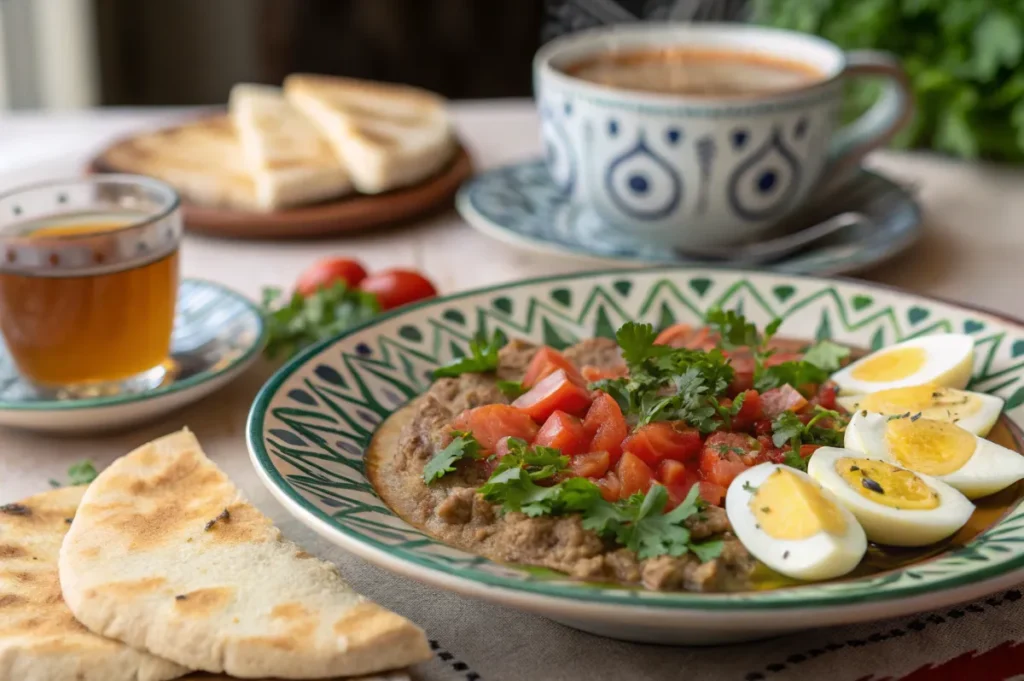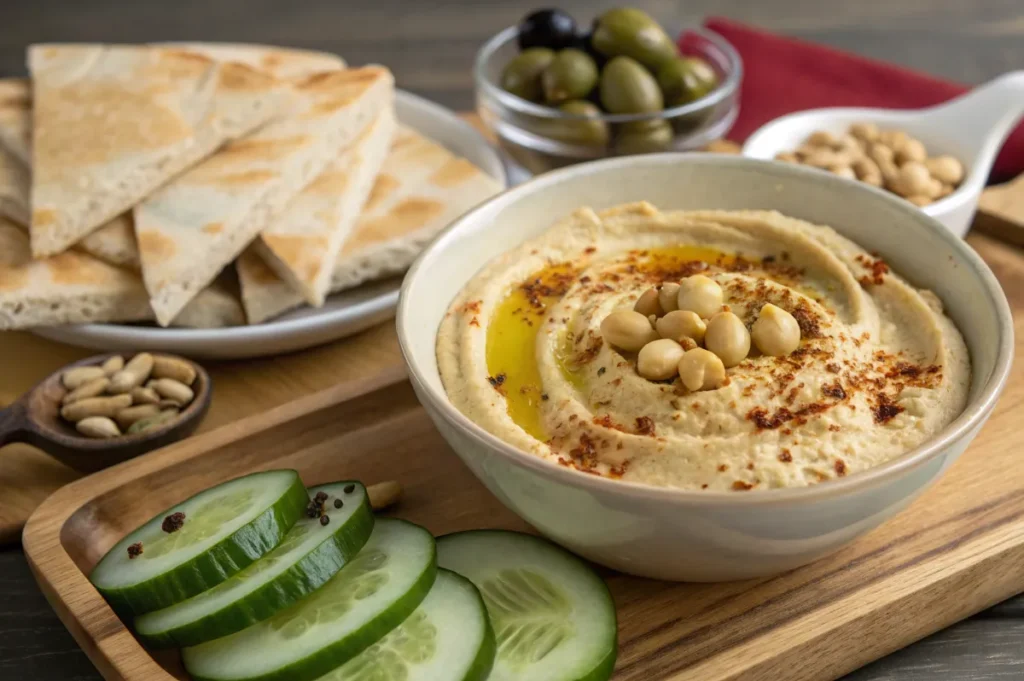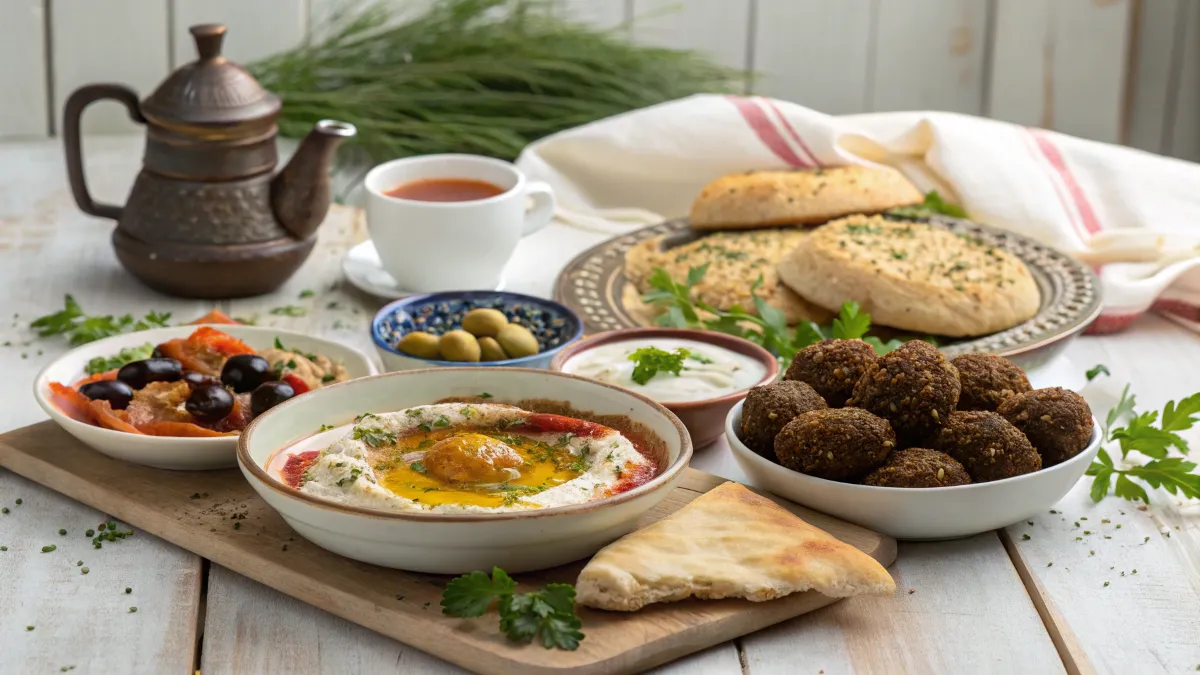Breakfast in the Arab world is more than just a meal—it’s a cultural experience. From the busy streets of Cairo to the warm kitchens of Beirut, morning tables are full of tasty dishes. These meals bring families and friends together.
In this guide, we’ll explore the best Arabic breakfast food recipes, breaking them down into classic dishes, breads, dips, and drinks that define a traditional Arabic breakfast. Whether you’re craving a warm bowl of ful medames, a crispy manakish, or a comforting cup of Arabic coffee, we’ve got you covered.
Let’s dive into the heart of Middle Eastern breakfasts, starting with what makes them unique!
Table of Contents
Introduction to Arabic Breakfast Cuisine
Arabic breakfasts are diverse, offering a mix of savory, sweet, and hearty flavors. Unlike Western breakfasts that often include cereal and toast, Arabic breakfast tables have mezze-style platters. These platters feature small portions of various dishes. These can include eggs, vegetables, olives, yogurt, and rich dips like hummus and labneh.
What Makes Arabic Breakfast Unique?
One thing that stands out about an Arabic breakfast is its variety and balance. It’s not just about eating; it’s about sharing. A traditional spread often includes a combination of:
- Proteins – Eggs, fava beans (ful medames), cheese, and yogurt.
- Carbs – Freshly baked breads like manakish, khobz, and fatayer.
- Healthy Fats – Olive oil, nuts, and sesame-based dips like tahini.
- Fresh Produce – Cucumbers, tomatoes, mint, and olives for added freshness.
Regional Variations in Arabic Breakfast Food
Arabic breakfast food recipes vary across regions:
- Levantine Breakfast (Lebanon, Syria, Jordan, Palestine) – Think za’atar manouche, labneh, and fresh vegetables.
- Egyptian Breakfast – A staple here is ful medames, a slow-cooked fava bean dish.
- Gulf & Yemeni Breakfast – Masoob (mashed banana bread pudding) and mutabbaq (stuffed savory pancakes) are local favorites.
Common Ingredients in Arabic Morning Dishes
If you want to create an authentic Arabic breakfast at home, keep these pantry essentials stocked:
- Fava beans – The base of ful medames.
- Zaatar & sumac – Signature Middle Eastern spices.
- Labneh – A thick, creamy yogurt cheese.
- Olive oil – Used generously for drizzling.
- Pita or flatbread – Essential for scooping up dips.
In the next section, we’ll dive into some classic Arabic breakfast dishes that you must try! Get ready to explore the flavors of the Middle East. 🍽️
Classic Arabic Breakfast Dishes You Must Try
Nothing defines Arabic breakfast food recipes better than the traditional, hearty dishes enjoyed across the Middle East. These meals are simple yet rich in flavor, packed with nutritious ingredients that fuel the day ahead. Whether it’s a warm plate of ful medames or a crispy slice of manakish, these dishes represent centuries of culinary tradition.
Ful Medames: The Egyptian Comfort Food
A staple in Egyptian cuisine, ful medames is a protein-packed dish made from slow-cooked fava beans, seasoned with olive oil, lemon juice, garlic, and cumin. It’s often topped with chopped tomatoes, onions, and boiled eggs for extra flavor.

💡 How to Make It:
- Soak dried fava beans overnight.
- Simmer them for a few hours until soft.
- Mash slightly, then mix with tahini, garlic, and olive oil.
- Serve with warm pita bread and fresh veggies.
Shakshuka: A Flavorful Middle Eastern Egg Dish
Originating from North Africa and the Middle East, shakshuka is a spiced tomato and egg dish that’s as satisfying as it is nutritious. The eggs are poached in a thick tomato sauce flavored with garlic, onions, cumin, and paprika.
💡 Serving Tip: Enjoy with khobz or pita bread to soak up every last bit of the rich, tangy sauce.
Egg-based dishes are a staple in Middle Eastern cuisine. For more inspiration, check out this Persian Egg Breakfast Guide featuring flavorful ways to enjoy eggs.
Manakish: The Arabic Breakfast Pizza
Think of manakish as the Middle Eastern version of pizza. It’s a flatbread topped with za’atar, cheese, or minced meat, then baked to crispy perfection.
💡 Popular Variations:
- Za’atar Manakish: Topped with olive oil and za’atar (a blend of thyme, sumac, and sesame seeds).
- Cheese Manakish: Uses Akkawi or Nabulsi cheese, giving it a slightly salty taste.
- Minced Meat Manakish: A favorite in Lebanese breakfast spreads.
Fatayer: Savory Arabic Breakfast Pastries
These delicious pastries come in different fillings, from spinach and feta to ground beef and onions. They are small, hand-held, and perfect for a quick, on-the-go breakfast.
💡 Pair it with: Labneh (strained yogurt) or a cup of mint tea for a refreshing balance.
Masoob: A Hearty Yemeni Banana-Based Breakfast
A unique dish from Yemen, masoob is a sweet, energy-packed breakfast made with mashed bananas, crumbled bread, honey, and cream.
💡 Why You’ll Love It: It’s naturally sweet and incredibly satisfying, perfect for those who prefer a sweeter breakfast option.
Bread & Pastries in Arabic Breakfast
Breads and pastries are the heart and soul of an Arabic breakfast table. Whether you prefer soft, fluffy flatbreads or crispy, layered pastries, these baked delights bring comfort and warmth to the morning meal.
Zaatar Manouche: A Lebanese Breakfast Staple
Manouche (plural: mana’eesh) is a thin, soft flatbread traditionally topped with za’atar and olive oil before baking. It’s a common sight in Lebanese bakeries, where it’s served hot and folded like a wrap for easy eating.
💡 Try It With: Slices of fresh cucumbers, tomatoes, and a cup of Arabic coffee.
Cheese Fatayer: Savory Arabic Pastries
These bite-sized stuffed pastries are filled with cheese, spinach, or minced meat. They’re golden brown, crispy on the outside, and soft inside.
💡 Why It’s Special: The cheese melts beautifully, making it a warm, gooey delight with every bite.
If you’re hosting a large gathering, you can combine these Arabic pastries with other breakfast ideas for a crowd to create a memorable and filling spread.
Khobz: Traditional Arabic Bread Varieties
In many Middle Eastern homes, no meal is complete without bread. Some of the most popular types include:
- Pita Bread: Soft, pocket-style bread perfect for dipping in hummus and labneh.
- Markook: A thin, chewy flatbread often used in Lebanese wraps.
- Taboon: A rustic, thick bread with a slightly smoky flavor.
💡 Best Served With: Olives, fresh herbs, and a drizzle of extra virgin olive oil.
Makdous: Pickled Eggplants for Breakfast
While not a bread, makdous is a popular breakfast side dish that pairs wonderfully with flatbreads. These small, oil-cured eggplants are stuffed with walnuts, garlic, and red pepper.
💡 Why You’ll Love It: It’s a flavor-packed addition to your Arabic breakfast spread.
Mezze and Dips for a Traditional Arabic Breakfast
An Arabic breakfast spread wouldn’t be complete without a selection of mezze and dips. These small dishes add flavor, texture, and balance to the meal, offering a variety of savory, creamy, and tangy bites to enjoy with flatbreads and fresh vegetables.
Hummus and Labneh: Breakfast Must-Haves
Two of the most common mezze dishes for breakfast are hummus and labneh. Both are simple yet incredibly flavorful, making them staples in Middle Eastern households.

- Hummus: This creamy chickpea dip is made by blending chickpeas, tahini, garlic, lemon juice, and olive oil.
- Labneh: A thick, strained yogurt that’s slightly tangy, often drizzled with olive oil and sprinkled with za’atar.
💡 Serving Tip: Enjoy them with warm pita bread or freshly chopped cucumbers and tomatoes.
Baba Ganoush: Smoky Eggplant Delight
If you love rich, smoky flavors, then baba ganoush is a must-try. Made from roasted eggplants, tahini, lemon juice, and garlic, this dip has a smooth, creamy texture and a deep, charred flavor.
💡 Pro Tip: For an extra punch, top it with pomegranate seeds or a drizzle of olive oil.
Olives & Pickles: The Essential Side Dishes
Olives and pickled vegetables are a classic addition to an Arabic breakfast. They enhance flavors, add crunch, and provide a tangy contrast to creamy dishes like labneh and hummus.
Popular choices include:
- Green and black olives marinated in olive oil, garlic, and herbs.
- Makdous (pickled eggplants) stuffed with walnuts and red pepper.
- Pickled turnips and cucumbers, which add a refreshing, crunchy bite.
💡 Why They Matter: These small sides bring a burst of flavor and texture to any Arabic breakfast food recipe.
Foul (Fava Beans): A Hearty, Protein-Rich Option
Similar to ful medames, foul (pronounced ‘fool’) is a simple dish of mashed fava beans mixed with olive oil, lemon juice, and spices. It’s often served alongside pita bread, fresh herbs, and tomatoes.
💡 Perfect Pairing: Enjoy it with a side of labneh or za’atar flatbread.
Beverages to Pair with an Arabic Breakfast
To complete an authentic Arabic breakfast, you need the perfect drink. Whether you prefer a strong cup of Arabic coffee or a soothing glass of mint tea, beverages play an essential role in the morning routine.
Arabic Coffee (Qahwa) and Its Significance
Qahwa, or Arabic coffee, is lightly roasted and spiced with cardamom, giving it a unique, slightly bitter taste. Unlike Western coffee, it’s brewed without milk or sugar and is served in small cups alongside dates or nuts.
💡 Did You Know? In Gulf countries, serving qahwa to guests is a symbol of hospitality and respect.
Mint Tea: The Refreshing Breakfast Companion
A classic breakfast drink in Levantine and North African cuisine, mint tea is sweet, fragrant, and calming. It’s made by brewing green tea leaves with fresh mint and sugar, then poured from a height to create a light foam.
💡 Best Time to Drink: Perfect after a rich breakfast to aid digestion.
Sahlab: A Creamy, Warm Breakfast Drink
For something thicker and more indulgent, sahlab is a Middle Eastern winter favorite. Made from orchid root powder, warm milk, and sugar, this smooth, pudding-like drink is often topped with cinnamon, coconut flakes, or crushed nuts.
💡 Pro Tip: It’s perfect for chilly mornings when you want something sweet and comforting.
Quick & Healthy Arabic Breakfast Recipes
Not every morning allows for a leisurely, elaborate breakfast spread. But that doesn’t mean you have to skip out on the rich flavors and nutritious elements of Arabic breakfast food recipes. Here are a few quick and healthy options that fit into a busy lifestyle while keeping the authentic taste of the Middle East.
Avocado Hummus Toast: A Modern Twist
Combining the creaminess of hummus with the healthy fats of avocado, this dish is a fusion of classic Arabic flavors with a modern twist. It’s nutrient-dense, quick to prepare, and packed with energy.
💡 How to Make It:
- Spread a generous layer of hummus on whole-grain toast.
- Mash half an avocado on top.
- Sprinkle with sumac, sesame seeds, and chili flakes for added flavor.
- Drizzle with extra virgin olive oil and enjoy!
Eggs with Sumac and Tomatoes
For a protein-packed breakfast, this dish takes less than 10 minutes to make and pairs beautifully with warm pita bread.
💡 How to Make It:
- Heat olive oil in a pan and sauté diced tomatoes.
- Crack eggs into the pan and let them cook gently.
- Sprinkle with sumac, salt, and pepper.
- Serve with feta cheese and olives.
Meyers Lemon Dill Relish on Hummus Toast
A tangy, refreshing take on hummus toast, this dish balances citrus, herbs, and creaminess for a light yet satisfying breakfast.
💡 Serving Suggestion: Pair with a glass of mint tea for a refreshing morning boost.
Healthy Variations of Arabic Breakfast Foods
For a lighter version of traditional Arabic breakfast food recipes, try these simple swaps:
- Use Greek yogurt instead of labneh for extra protein.
- Replace white bread with whole wheat pita.
- Opt for baked falafel instead of fried.
FAQs About Arabic Breakfast
Curious about Arabic breakfast traditions? Here are some common questions people ask when exploring this flavorful cuisine.
What is a typical Arabic breakfast?
A traditional Arabic breakfast is a mezze-style meal with a mix of:
- Proteins – Eggs, cheese, or fava beans (ful medames).
- Breads & Pastries – Pita, manakish, or fatayer.
- Dips & Sides – Hummus, labneh, baba ganoush, olives, and pickled vegetables.
- Beverages – Arabic coffee or mint tea.
Most dishes are served family-style, allowing for sharing and socializing over food.
What is a traditional Lebanese breakfast?
A Lebanese breakfast is a blend of fresh, wholesome ingredients, often including:
- Za’atar manouche (thyme-spiced flatbread).
- Labneh with olive oil.
- Kibbeh or falafel (for a heartier option).
- Fresh cucumbers, tomatoes, and mint leaves.
What are three traditional Arabic breakfast dishes?
If you’re looking to start your day the Middle Eastern way, try these:
- Ful Medames – Slow-cooked fava beans with olive oil, garlic, and lemon.
- Shakshuka – Eggs poached in a rich, spiced tomato sauce.
- Manakish – A Middle Eastern flatbread topped with za’atar, cheese, or ground meat.
What do Yemenis eat for breakfast?
Yemeni breakfasts are unique and hearty, often featuring:
- Masoob – A banana, honey, and bread pudding packed with energy.
- Mutabbaq – A crispy stuffed pancake with savory or sweet fillings.
- Saltah – A spicy meat stew sometimes eaten in the morning.
Yemeni breakfasts are typically enjoyed with a strong cup of black tea flavored with cardamom.
Conclusion: Embracing the Richness of Arabic Breakfast Food Recipes
Arabic breakfast food recipes are more than just morning meals—they’re a celebration of culture, tradition, and community. Whether it’s the hearty ful medames of Egypt, the cheesy manakish of Lebanon, or the sweet masoob of Yemen, each dish tells a story of heritage and flavor.
From mezze spreads to warm, freshly baked breads and refreshing beverages, Arabic breakfasts strike the perfect balance between nutrition and indulgence. Best of all, they’re often simple to prepare, allowing you to bring the authentic taste of the Middle East into your own kitchen.
💡 So why not start your day with a taste of Arabia? Try one of these dishes tomorrow and experience the magic of Middle Eastern flavors!
Let me know if you’d like more Arabic breakfast recipes or meal-planning ideas! 😊

Arabic Breakfast
Ingredients
Method
- Soak dried fava beans overnight in water.
- Simmer the soaked beans for 2-3 hours until soft.
- Mash slightly and mix with tahini, garlic, and olive oil.
- Serve with chopped tomatoes and boiled eggs.
- Sauté diced onions and garlic until soft.
- Add tomato sauce and spices, simmering for 10 minutes.
- Make wells in the sauce and crack eggs into them.
- Cover and cook until eggs are just set.
- Prepare dough with flour and water; let rise for 1 hour.
- Roll out dough into flat circles.
- Top with za'atar and olive oil, then bake until golden.

